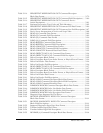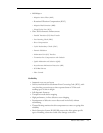
Maxtor Atlas 10K V 1-3
The typographical and naming conventions used in this manual are listed below.
Conventions that are unique to a specific table appear in the notes that follow that
table.
Typographical Conventions:
• Names of Bits: Bit names are presented in initial capitals. An example is
the Host Software Reset Bit.
• Commands: Firmware commands are listed as all capitals. An example is
MODE SELECT.
• Parameters: Parameters are given as initial capitals when spelled out, and
are given as all capitals when abbreviated. Examples are Prefetch Enable
(PE) and Cache Enable (CE).
• Hexadecimal Notation: The hexadecimal notation is given in 9-point
subscript form. An example is 30
H
.
• Signal Negation: A signal that is non-active or is in its non-asserted state.
• Messages: A message that is sent from the drive to the host is listed in all
capitals. An example is BUS DEVICE RESET.
Naming Conventions:
• Host: In general, the system in which the drive resides is referred to as
the host.
• Computer Voice: This refers to items you type at the computer
keyboard. These items are listed in 10-point, all capitals, Courier font.
An example is FORMAT.
1.4 REFERENCES
For additional information about the SCSI interface, refer to:
• ANSI Small Computer System Interface-2 (SCSI-2) Specification, ANSI
X3T9.2/86-109, Revision 10k.
• ANSI Small Computer System Interface-3 (SCSI-3) Specification, ANSI
X3T10, August 1994.
• SPI-3 Specification Revision SPI-4 Spec Revision 10


















